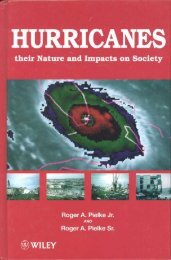Impacts of land use land cover on temperature trends over the ...
Impacts of land use land cover on temperature trends over the ...
Impacts of land use land cover on temperature trends over the ...
Create successful ePaper yourself
Turn your PDF publications into a flip-book with our unique Google optimized e-Paper software.
Barren<br />
to<br />
Urban<br />
Barren<br />
to<br />
Forest<br />
S. FALL ET AL.<br />
(a) (b)<br />
°C / 10yr<br />
(c)<br />
°C / 10yr<br />
Urban<br />
to<br />
Forest<br />
Forest<br />
to<br />
Urban<br />
Grass/Shrub<br />
to<br />
Urban<br />
Grass/Shrub<br />
to<br />
Forest<br />
(e)<br />
°C / 10yr<br />
Agriculture<br />
to<br />
Urban<br />
Agriculture<br />
to<br />
Forest<br />
Urban<br />
to<br />
Agriculture<br />
°C / 10yr<br />
(d)<br />
°C / 10yr<br />
Barren<br />
to<br />
Agriculture<br />
Urban<br />
to<br />
Barren<br />
Urban<br />
to<br />
Grass/Shrub<br />
Forest<br />
to<br />
Agriculture<br />
Forest<br />
to<br />
Barren<br />
Barren<br />
to<br />
Grass/Shrub<br />
Grass/Shrub<br />
to<br />
Agriculture<br />
Grass/Shrub<br />
to<br />
Barren<br />
Forest<br />
to<br />
Grass/Shrub<br />
Agriculture<br />
to<br />
Barren<br />
Agriculture<br />
to<br />
Grass/Shrub<br />
Figure 9. (a) Decadal OMR <strong>trends</strong> <str<strong>on</strong>g>of</str<strong>on</strong>g> NLCD LULC types that were c<strong>on</strong>verted to urban during 1992–2001, (b) except for barren <str<strong>on</strong>g>land</str<strong>on</strong>g>s, (c) except<br />
for forests,(d) except for grass<str<strong>on</strong>g>land</str<strong>on</strong>g>s/shrub<str<strong>on</strong>g>land</str<strong>on</strong>g>s, (e) except for agriculture. Error bars denote 95% c<strong>on</strong>fidence intervals.<br />
a moderate or small warming (0.041 and 0.018 °C<br />
respectively), while areas that were previously grass<str<strong>on</strong>g>land</str<strong>on</strong>g>/shrub<str<strong>on</strong>g>land</str<strong>on</strong>g><br />
and urban have slightly negative OMRs<br />
(−0.016 and −0.019 °C respectively). The largest variability<br />
is found in areas that shifted from grass<str<strong>on</strong>g>land</str<strong>on</strong>g>/shrub<str<strong>on</strong>g>land</str<strong>on</strong>g><br />
to forest (standard deviati<strong>on</strong>: 0.36 °C).<br />
Results for areas that were previously urban have less<br />
reliability due to a small sample size. The warming effect<br />
<str<strong>on</strong>g>of</str<strong>on</strong>g> lower surface albedo that results from afforestati<strong>on</strong><br />
(Betts 2000; Feddema et al., 2005; Gibbard et al., 2005;<br />
Betts et al., 2007) was not seen in our results. Similarly,<br />
Hale et al. (2008) did not find a clear pattern in areas that<br />
experienced a clearcutting <str<strong>on</strong>g>of</str<strong>on</strong>g> forests.<br />
Decadal OMR <strong>trends</strong> for areas that have been c<strong>on</strong>verted<br />
to grass<str<strong>on</strong>g>land</str<strong>on</strong>g>/shrub<str<strong>on</strong>g>land</str<strong>on</strong>g> are presented in Figure<br />
9(d). With <strong>the</strong> excepti<strong>on</strong> <str<strong>on</strong>g>of</str<strong>on</strong>g> areas that were previously<br />
urban, where a slight cooling occurs (−0.023 °C), c<strong>on</strong>versi<strong>on</strong><br />
to grass<str<strong>on</strong>g>land</str<strong>on</strong>g>/shrub<str<strong>on</strong>g>land</str<strong>on</strong>g> is associated with a modest<br />
warming. Trends <str<strong>on</strong>g>of</str<strong>on</strong>g> areas that were previously forested<br />
and agricultural (0.052 and 0.045 °C respectively) are<br />
Copyright © 2009 Royal Meteorological Society Int. J. Climatol. (2009)<br />
DOI: 10.1002/joc














